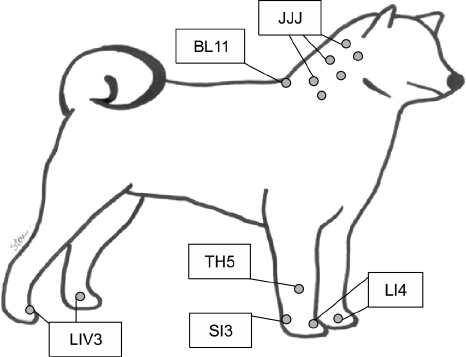J Vet Sci.
2016 Sep;17(3):337-345. 10.4142/jvs.2016.17.3.337.
Retrospective study of the clinical effects of acupuncture on cervical neurological diseases in dogs
- Affiliations
-
- 1National Taiwan University Veterinary Hospital, Taipei 10617, Taiwan.
- 2Department and Graduate Institute of Veterinary Medicine, School of Veterinary Medicine, National Taiwan University, Taipei 10617, Taiwan.
- 3Institute of Veterinary Clinical Sciences, School of Veterinary Medicine, National Taiwan University, Taipei 10617, Taiwan. ctlin@ntu.edu.tw
- KMID: 2413133
- DOI: http://doi.org/10.4142/jvs.2016.17.3.337
Abstract
- This study was conducted to evaluate new acupuncture protocols for the clinical treatment of cervical spinal cord diseases in 19 dogs. Three treatment options containing Jing-jiaji (cervical jiaji) were developed to treat neck pain, hemiparesis, and tetraparesis depending on the severity. The interval between the neurological disease onset and treatment (duration of signs), time to improvement after treatment, and recovery time were compared in dogs by body weight, age, and dry needle acupuncture (AP) with or without electro-AP (EAP). The duration of signs was longer in dogs weighing greater than 10 kg than in those weighing less than 10 kg (p < 0.05). Improvement and recovery times did not vary by body weight. Additionally, improvement and recovery times did not vary by age. The improvement and recovery times were longer in the AP+EAP group than the AP group (p < 0.05). Acupuncture with Jing-jiaji was effective in cervical spinal cord diseases in different sized dogs and in middle-aged and senior dogs. This report standardized AP treatment containing Jing-jiaji for canine cervical problems and evaluated its effects. The newly standardized AP methodology offers clinical practitioners an effective way to improve the outcomes of cervical neurological diseases in dogs.
MeSH Terms
Figure
Reference
-
1. Cabioglu MT, Arslan G. Neurophysiologic basis of Back-Shu and Huatuo-Jiaji points. Am J Chin Med. 2008; 36:473–479.
Article2. Cheng W, Chen J, Guo B. Effect of different needling depths on the therapeutic efficacy of acupuncture at cervical Jiaji points (Ex-B 2) for cervical spondylosis. Shanghai J Acupunct Moxib. 2013; 32:36–37.3. Chrisman CL. Spinal cord disorders. In : Xie H, Chrisman C, Trevisanello L, editors. Traditional Chinese Veterinary Medicine for Neurological Diseases. Proceedings of the 13th Annual International TCVM Conference. Reddick: Jing Tang Publishing;2011. p. 225–322.4. Chrisman CL. Treatment of neurological disorders with traditional Chinese veterinary medicine. In : Platt SR, Olby NJ, editors. BSAVA Manual of Canine and Feline Neurology. 4th ed. Gloucester: British Small Animal Veterinary Association;2013. p. 496–507.5. Deadman P, Al-khafaji M, Baker K. The extra points. A Manual of Acupuncture. 2nd ed. Hove: Journal of Chinese Medicine Publications;2007. p. 574–575.6. Go VL, Yaksh TL. Release of substance P from the cat spinal cord. J Physiol. 1987; 391:141–167.
Article7. Hillman RB, Kengeri SS, Waters DJ. Reevaluation of predictive factors for complete recovery in dogs with nonambulatory tetraparesis secondary to cervical disk herniation. J Am Anim Hosp Assoc. 2009; 45:155–163.
Article8. Janssens LAA. The treatment of canine cervical disc disease by acupuncture: a review of thirty-two cases. J Small Anim Pract. 1985; 26:203–212.
Article9. Janssens LAA. Acupuncture for the treatment of thoracolumbar and cervical disc disease in the dog. Probl Vet Med. 1992; 4:107–116.10. Kendall DE. Part I: a scientific model of acupuncture. Am J Acupunct. 1989; 17:251–268.11. Kendall DE. Part II: a scientific model of acupuncture. Am J Acupunct. 1989; 17:343–360.12. Kline KL. Complementary and alternative medicine for neurologic disorders. Clin Tech Small Anim Pract. 2002; 17:25–33.
Article13. Leung L. Neurophysiological basis of acupuncture-induced analgesia—an updated review. J Acupunct Meridian Stud. 2012; 5:261–270.
Article14. Liu Y, Hu J, Zhang H, Huang G, Zhou L. Clinical study on analgesic effect of acupoint injection at cervical jiaji points for the treatment of cervical spondylosis of nerve root type. Chin J Tradit Med Traumatol Orthop. 2009; 17:28–29.15. Omura Y. Patho-physiology of acupuncture treatment: effects of acupuncture on cardiovascular and nervous systems. Acupunct Electrother Res. 1975; 1:51–140.16. Park SW, Yan YP, Satriotomo I, Vemuganti R, Dempsey RJ. Substance P is a promoter of adult neural progenitor cell proliferation under normal and ischemic conditions. J Neurosurg. 2007; 107:593–599.
Article17. Sherman J, Olby NJ, Halling KB. Rehabilitation of the neurological patient. In : Platt SR, Olby NJ, editors. BSAVA Manual of Canine and Feline Neurology. 4th ed. Gloucester: British Small Animal Veterinary Association;2013. p. 481–495.18. Smith FW Jr. Neurophysiologic basis of acupuncture. Probl Vet Med. 1992; 4:34–52.19. Xie H, Preast V. Xie's Veterinary Acupuncture. Ames: Wiley-Blackwell;2007.20. Xie H, Frank LR, Preast V, Trevisanello L. Chinese Veterinary Herbal Handbook. 3rd ed. Reddick: Jing Tang Publishing;2011.21. Zhang LY, Zhao GJ. Research and application of Huatuo-Jiaji points. Chin Acupunct Moxib. 1998; 18:695–697.22. Zhang Y, Wang C, Guo Y. The progress of clinical research on cervical spondylosis treated with acupoint injection in recent five years. Chin Acupunct Moxib. 2012; 32:477–479.
- Full Text Links
- Actions
-
Cited
- CITED
-
- Close
- Share
- Similar articles
-
- Cervical Spinal Cord Injury Caused by Acupuncture
- Cervical Prevertebral Hematoma - a Rare Complication of Acupuncture Therapy: A Case Report
- Surgical treatment of spinal cord compression in client owned dogs with different grades of neurological dysfunction
- Acupuncture treatment for idiopathic Horner's syndrome in a dog
- Cardiac Tamponade Caused by Epigastric Acupuncture: A Case Report


